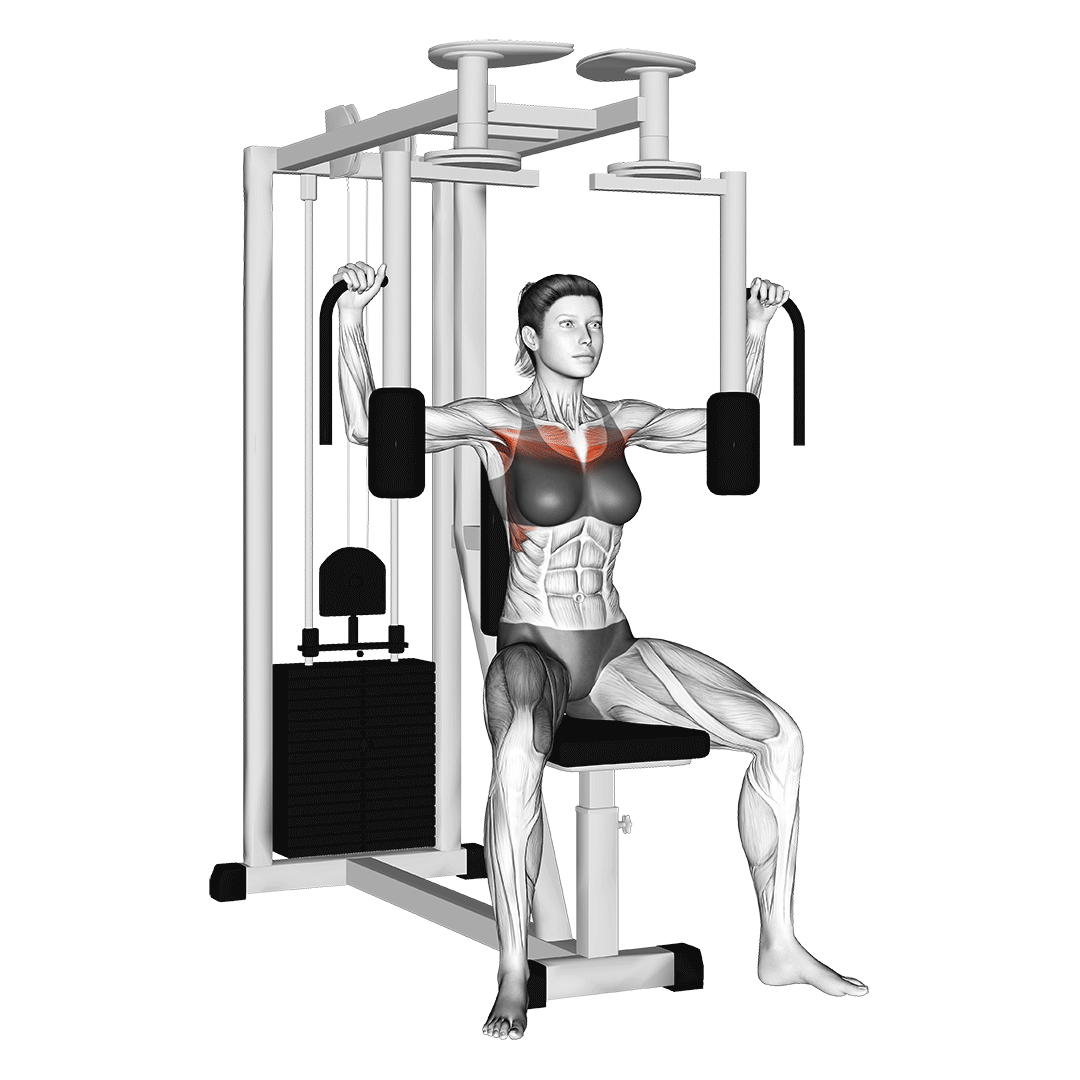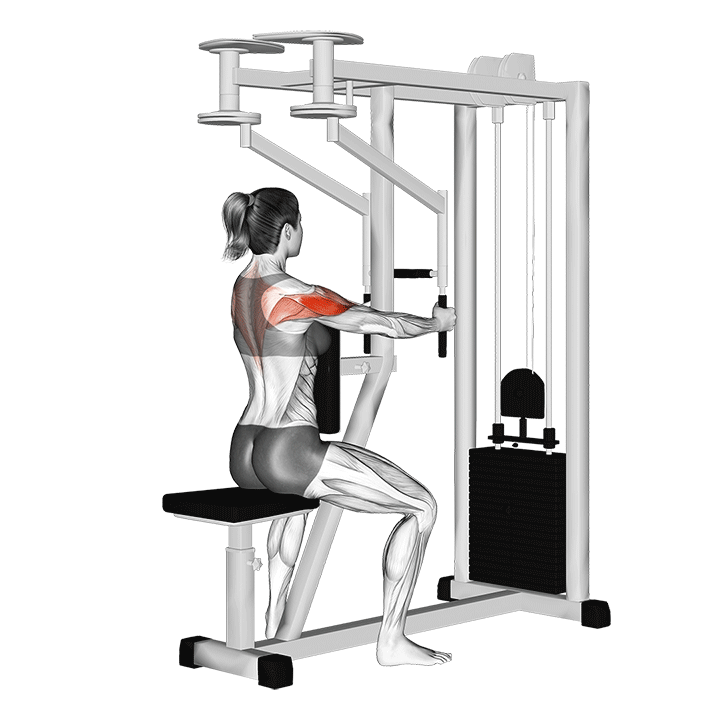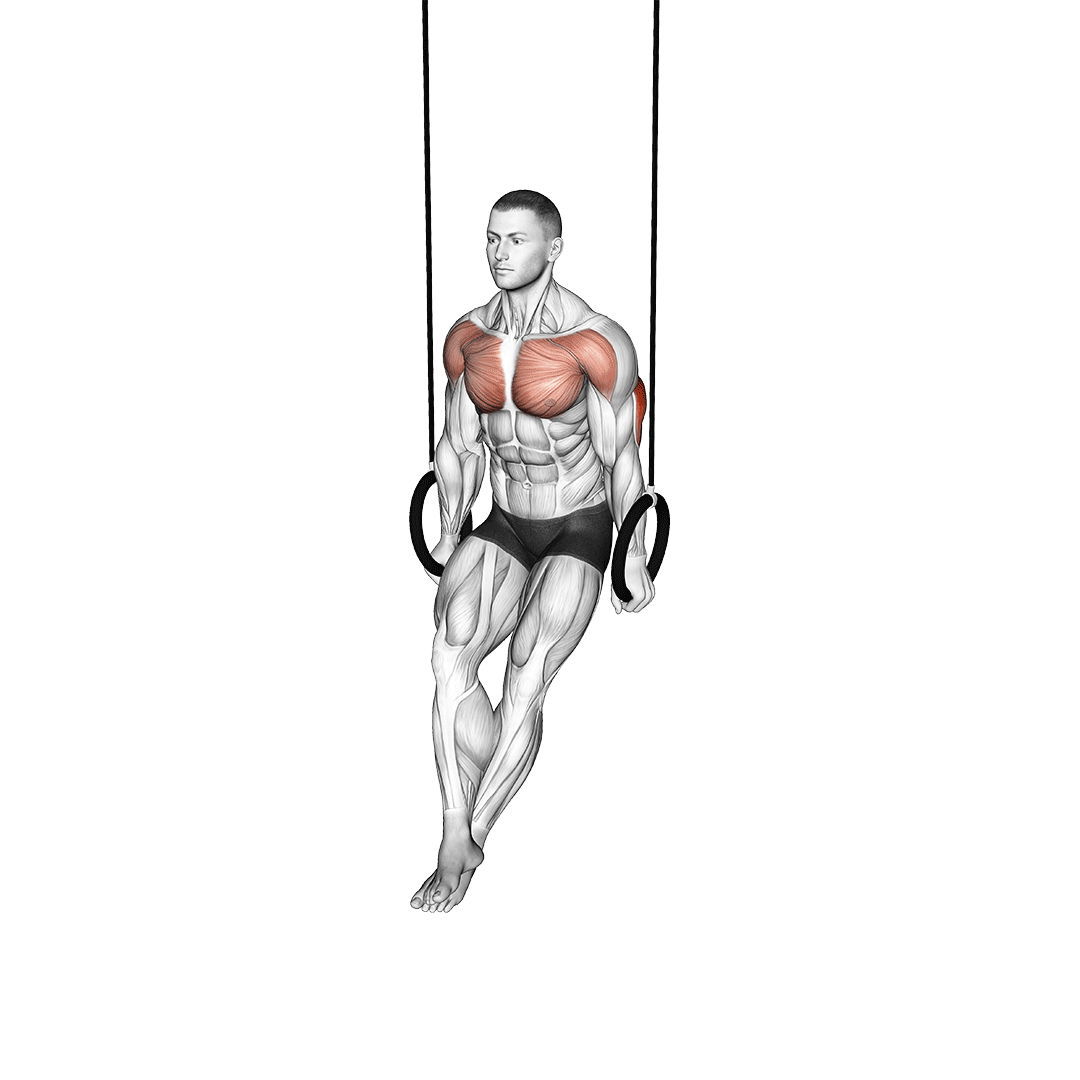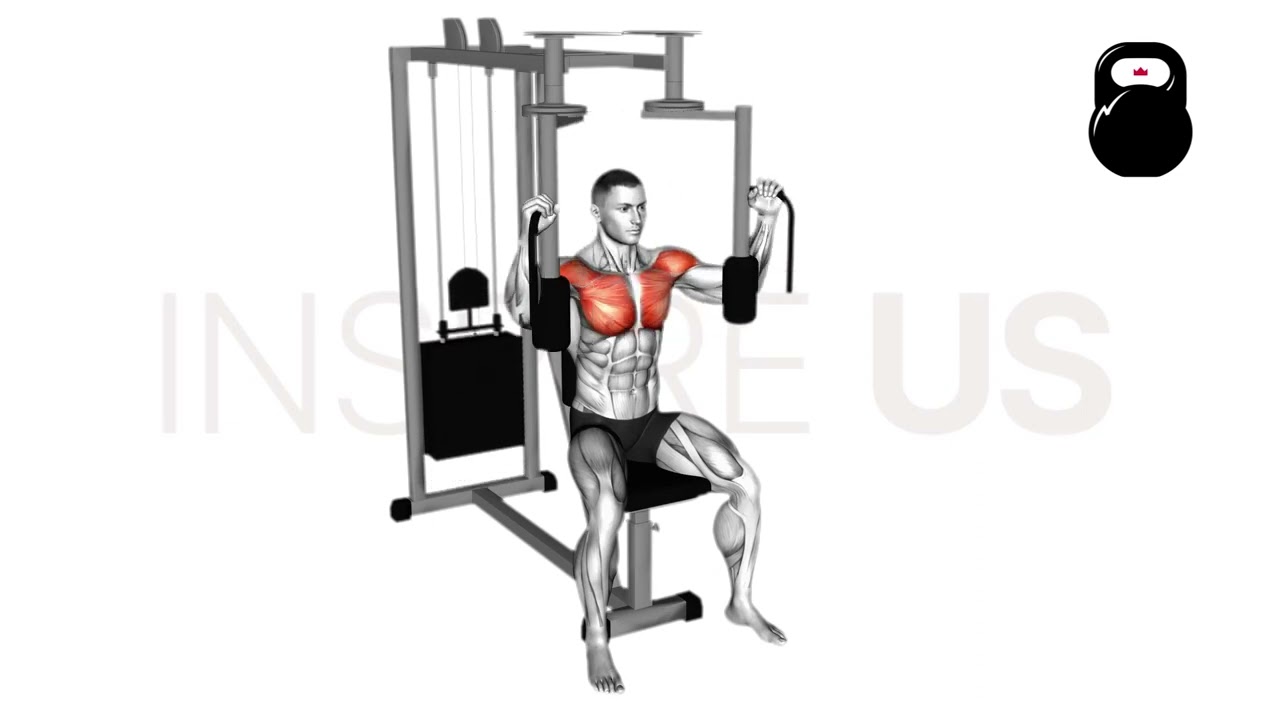Pec Deck Machine: Benefits, Muscles Worked, and More
The pec deck exercise is a classic chest isolation movement best performed with the use of its namesake machine.
Most often, the movement itself is included into weightlifting programs for its benefits regarding pectoral muscle mass, improved bench press performance and reinforcement of arm adduction mechanics.
What are Pec Decks?
Pec decks are a machine-based isolation exercise involving the lifter drawing their arms towards the midline of their body against resistance.

In actual programming, pec decks are used for inducing muscular hypertrophy in the pectoral muscles.
Outside of this sort of training stimulus, they do not serve many other purposes, hence the fact that they are primarily included into bodybuilding programs or similar hypertrophy-focused workout plans.
This sort of programming comes as a result of the fact that pec decks - and by extension the pec deck machine - are noted for being quite simplistic and safe to use.
With relatively little impact to the joints and a high capacity for volume, the pec deck excels as an accessory movement programmed after heavier movements like the bench press or push-up have already been completed.
Are Pec Decks the Right Exercise for You?
Pec decks are quite safe, and are suitable for even the most green of novices. So long as they are programmed correctly, there is very little risk of injury present.
However, those with a history of issues with their shoulders, biceps, elbows or chest may wish to first speak to a medical professional prior to attempting a set of pec decks. The upright position of the body combined with the angle of resistance can irritate these areas if they are susceptible.
How to Use a Pec Deck Machine
To perform a repetition of the pec deck, the lifter will seat themselves within its namesake machine, back to the pads and a moderate amount of resistance selected.
Reaching their arms out to the sides and grasping the handles with their elbows pressed against the pads (if available), the lifter then braces their core, partially retracts their scapula and ensures their head is aligned over the rest of the body.
Now positioned correctly, the lifter squeezes their chest and draws the handles towards each other at the front of the torso, ensuring they do not lean forwards as they do so.
When the handles are nearly touching, the lifter then slowly releases tension in their chest, allowing the resistance of the machine to pull their arms back outwards in a slow and controlled manner.
Once back in the original position with their arms raised at the sides of the torso, the repetition is considered to be complete.
Sets and Reps Recommendation:
Pec decks are meant to be performed for high volume sets featuring significant lengths of time under tension.
Those seeking greater chest mass should perform 2-3 sets of 12-18 repetitions at a moderate level of resistance.
What Muscles are Worked by Pec Decks?
Pec decks are an isolation exercise, meaning that they only really work a single muscle group in a dynamic fashion. This, of course, are the pectoral muscles that make up the chest area.

Because the pectoral muscles are primarily responsible for stabilizing and creating arm adduction (moving towards the midline), the pec deck is particularly effective at targeting the entire muscle group, regardless of whether pectoralis minor or major.
What are the Benefits of Doing Pec Decks?
Pec decks are so widely performed due to the advantages they offer in terms of simplicity, volume capacity and range of motion. If stronger and larger chest muscles are among your goals, then consider including the pec deck into your program.
Builds Pectoral Mass, Strength and Stability
Pec decks are particularly effective at building strength, stability and size in the pectoral muscles due to their isolated manner of contraction.
Combined with a comprehensive range of motion and a constant time under tension, pectoral development becomes all but inevitable when regularly performing pec decks.
For the best results, perform pec decks are completing a heavier compound chest movement such as the bench press, dips or push-ups. Ensure that a full range of motion is achieved with each repetition, and aim for a sufficiently lengthy time under tension.
Fixed Range of Motion and Movement Pattern
In comparison to similar exercises like the dumbbell chest fly or cable crossovers, the pec deck machine essentially “locks in” the path with which the arms move.
While this may feel somewhat limiting in comparison, it also ensures that very little risk of injury is present, and that the lifter is forced to complete a full range of motion without cheating the repetition through shortening their ROM.
In addition, this fixed movement pattern allows for greater stability of the overall movement, allowing for greater loading and volume capacity as a result of reduced isometric contraction being demanded of the muscles.
Reinforces Arm Adduction Biomechanic
By strengthening the pectoral muscles and stretching their requisite tendons in a full range, the pec deck can improve the lifter’s conscious capacity to perform arm adduction.
Not only will they be able to do so with greater force, but the lifter will find that general adduction of their arms will be generally more stable and possible to a comparatively greater range than before.
Of course, in order to have truly comprehensive arm/shoulder joint biomechanics, ensure that a synergistic arm abduction exercise or stretch is also performed alongside the pec deck.
Excellent as an Accessory Movement for Mass
Not all exercises are appropriate for acting as both an accessory movement and one specifically geared for muscular hypertrophy.
Such criteria is only further narrowed when speaking specifically of chest isolation exercises - of which is quite difficult to activate without also including the triceps or anterior deltoids in a significant capacity.
Fortunately, the pec deck machine fits all these needs and more, acting as the perfect accessory exercise for maximizing muscular hypertrophy of the pectoral muscles.
To ensure hypertrophy can actually be stimulated, aim for a moderate or high number of repetitions per set and ensure that the chest is subjected to a sufficiently long time against the machine’s resistance.
Comparatively Safer, More Accessible and Simpler
In comparison to other chest isolation exercises of its kind, the pec deck machine is among the safest and most simplistic - benefits owing to its machine-based nature and fixed range of motion.
Being safer and more accessible allows the pec deck machine to act as an unintimidating introduction to chest exercises for novices or those who have just recently returned to training.
Furthermore, these same advantages also allow the pec deck machine to be performed to a level of exertion that would otherwise be unsafe for free weight chest exercises. Lifters will be able to truly push the limits of their pectoral muscles without fear of acute injury - so long as proper form is followed.
Common Machine Pec Deck Mistakes to Avoid
Although pec decks are quite safe, avoid the following mistakes to avoid joint irritation and get the most out of your training.
Incorrect Torso Orientation
The most important aspect of pec deck stance is the orientation or angle of the torso as the exercise is performed.
Leaning backwards (if possible) can cause the scapula to protract and lead to impingement of the shoulders, whereas leaning forwards can also strain the mobility of the chest, shoulders and elbows as well.
Aim to keep the torso flush against the backrest if available, or to otherwise keep the chest aligned over the hips while in a seated position. Keep the head and neck aligned with the rest of the body.
Poor Range of Motion
In order to work the chest as effectively as possible, the lifter should seek to complete a full range of motion with each repetition.
This is achieved by starting and ending the repetition with the arms spread out to the sides, whereas the peak of the movement should involve the hands nearly touching together at the front of the body.
A poor range of motion can lead to the development of muscular imbalances, sticking points and generally poor development of the chest. If you are having difficulty completing a full range of motion with each repetition, it is possible you are fatigued or are attempting to lift too much weight.
Excessively Rapid Tempo
Much like an incomplete range of motion, an excessively rapid tempo can cause poor development - as well as tears of the pectoral muscles at greater levels of intensity.
In order to get the most out of the pec deck machine, lifters should strive to keep the tempo of each repetition at a relatively slow speed, especially in regards to the eccentric (widening) phase. Avoid rushing the repetitions, as this will force the body to absorb greater force and lead to poorer training stimulus as a whole.
Flaring Elbows Over Shoulders
A common mistake seen among those new to the pec deck is flaring of the elbows out to the sides. This rotates the humerus within the shoulder joint in an irritating manner, potentially leading to chronic overuse injuries of the shoulder.
If pads are available, aim to press the elbows against them for a more ideal humeral angle. Otherwise, simply avoid raising the upper arms above a parallel point to the shoulders.
Failing to Bend Elbows/Bending Elbows Too Much
Some level of elbow flexion should be present in order to avoid injuring the arms and to drive greater engagement of the pectoral muscles.
However, creating too much of a bend (to the point where the biceps are engaged) or failing to do so at all are also common mistakes frequently seen with the pec deck.
An ideal pec deck repetition will involve the elbows featuring as little of a bend as possible - but nonetheless still shy of fully locking out the arms.
Incorrect Adjustment of Machine
The majority of pec deck machine brands allow for adjustment of nearly every aspect of the exercise. From seat height to what sort of grip orientation is used, the pec deck machine can be tailor-fit to any individual lifter’s needs.
The mistake comes when lifters adjust the machine incorrectly for their training goals.
Adjusting the seat too high (in relation to the handles) can increase shoulder strain, whereas too low may lead to impingement and poor chest contraction. Setting the handles too far back can lead to strain and acute injury of the chest, whereas too far forwards will limit range of motion.
Strive to keep the handles around chest-height by adjusting the seat and sitting upright, and to further keep the handles themselves several inches away from the arms while they hang slack at the sides of the body.
Variations and Alternatives to Using the Pec Deck Machine
If no pec deck machine is available in your gym - or you want to hit your chest muscles in a slightly different way - try the following alternatives and variations out.
Pec Deck Reverse Flys
To target the posterior deltoids and upper back muscles with the use of a pec deck machine, simply reverse your position and face towards the backrest, if available.

Adjust the handles ahead of the chest and grasp them so that you may rotate the upper arms outwards, squeezing the shoulder blades as you do so.
Although the pec deck reverse fly isn’t quite a substitute to the conventional pec deck, it acts as the perfect antagonist exercise for supersets or comprehensive full body workouts.
Cable High Crossovers
The high cable crossover is a cable machine alternative to the pec deck that allows for a larger range of motion to be achieved. In trade, cable crossovers involve a less fixed movement pattern and may be somewhat less comfortable on the arms in comparison.

Use cable high crossovers if you wish to better emphasize the upper section of the pectoral muscles, or if you find the pec deck to be too limiting in terms of movement or ROM.
Gymnastic Ring Dips
For a more intense compound substitute to the pec deck, performing chest dips with the use of gymnastic rings is one highly effective option.

Unlike the pec deck machine, the ring dip will target the triceps brachii, anterior deltoids, serratus and core to a far more intense degree - as well as challenge the lifter’s balance, coordination and training experience.
If simply seeking a substitute isolation exercise for pectoral muscle hypertrophy, avoid ring dips.
However, if no horizontal push compound movement is present in your workout, consider substituting the pec deck with ring dips.
Frequently Asked Questions (FAQ)
Is the Pec Deck and Butterfly the Same?
Among other names, the pec deck is also simply referred to as butterflies due to the wing-like motion it involves.
Rest assured, both butterflies and pec decks are performed in the exact same way and result in much the same benefits.
Do Pec Decks Increase Chest Size?
Absolutely. Pec decks are excellent for inducing muscular hypertrophy of the chest in an isolated manner - which essentially means that it builds up chest size without involving other muscle groups, which may limit how many reps you can do or tire you out.
Are Pec Decks Better Than Chest Presses?
Pec decks and chest presses are two entirely separate exercises that serve somewhat distinct purposes.
The chest press in - all its variations - is done for building horizontal pushing strength and developing mass in the triceps and pecs.
In comparison, pec decks solely target the pectoral muscles, and are less of a strength-geared exercise than one more focused on pure mass.
A suitable push day workout will ideally involve both exercises, or similar if needed.
References
1. Stoppani, Jim. "Hit the deck: we investigate the differences between the pec-deck and machine flye." Joe Weider's Muscle & Fitness, December 2008, 248. Gale Academic OneFile (accessed November 8, 2023). https://link.gale.com/apps/doc/A188906921/AONE?u=googlescholar&sid=sitemap&xid=1e6b533e.
2. Solstad TE, Andersen V, Shaw M, Hoel EM, Vonheim A, Saeterbakken AH. A Comparison of Muscle Activation between Barbell Bench Press and Dumbbell Flyes in Resistance-Trained Males. J Sports Sci Med. 2020 Nov 19;19(4):645-651. PMID: 33239937; PMCID: PMC7675616.
3. López-Vivancos, Abraham, Noelia González-Gálvez, Francisco Javier Orquín-Castrillón, Rodrigo Gomes de Souza Vale, and Pablo Jorge Marcos-Pardo. 2023. "Electromyographic Activity of the Pectoralis Major Muscle during Traditional Bench Press and Other Variants of Pectoral Exercises: A Systematic Review and Meta-Analysis" Applied Sciences 13, no. 8: 5203. https://doi.org/10.3390/app13085203

